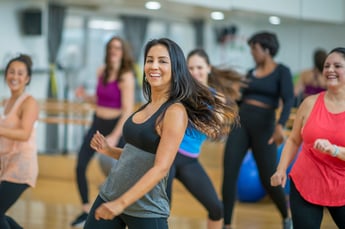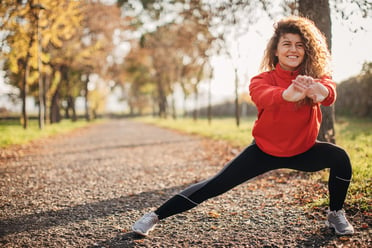 The holidays always bring a lot of fun, joy, and memories but they can also bring a lot of sugar crashes, mindless eating, and possible setbacks to our health and fitness goals. There are many reasons why trying to be mindful of what we’re eating around the holidays is important. One being energy management – you feel more energized when you take the time to include nutrient dense food alongside your favorite holiday dishes and treats. Second, you’re helping support your health and wellness goals – while enjoying yourself over the holidays is fine, making time to include foods that push us towards our goals and being more mindful of the things that could derail them is very important. Lastly, making sure to include foods with fiber and staying well hydrated will also aid in digestion and blood sugar regulation which are key components of our overall health.
The holidays always bring a lot of fun, joy, and memories but they can also bring a lot of sugar crashes, mindless eating, and possible setbacks to our health and fitness goals. There are many reasons why trying to be mindful of what we’re eating around the holidays is important. One being energy management – you feel more energized when you take the time to include nutrient dense food alongside your favorite holiday dishes and treats. Second, you’re helping support your health and wellness goals – while enjoying yourself over the holidays is fine, making time to include foods that push us towards our goals and being more mindful of the things that could derail them is very important. Lastly, making sure to include foods with fiber and staying well hydrated will also aid in digestion and blood sugar regulation which are key components of our overall health.
Energy Maintenance
This time of year often includes work holiday parties, family gatherings, and many other events that make our schedule busy. Maintaining energy through what you eat can be a big help in not getting slowed down by all the holiday fun. There are a few ways to help make sure you feel great and enjoy yourself. One way to stay energized is to prioritize protein and fiber! Including things like fruit, veggies, nuts, and Greek yogurt or even making the switch to whole grain crackers are great ways to snack and enjoy with your health and fitness goals in mind by providing micronutrients and helping you stay fuller longer. Another way is to have emergency snacks with you – things like protein bars, dried fruit, or string cheese are a great way to prioritize your goals while being busy during the holiday season.
Staying On Track
Mindful, smart snacking is important in not deterring your health and fitness goals. While the actual holidays are typically only one to two days, we all know that the treats and festivities trickle all throughout December. One way to make sure that office holiday party doesn’t create a setback is slow, intentional eating. This allows you to be mindful about not only what you’re consuming but also helps you to take the time to listen to hunger cues that your body gives you. Another tip is to make healthy options seasonal and fun. Holiday fruits like oranges, pomegranates, and apples with cinnamon help make things festive but keep you right on track through New Years.
Overall, Health and Longevity
Your hydration and digestion are a huge component of not only succeeding in your health and fitness goals but in your overall longevity. Prioritizing water/herbal tea at your holiday events is going to keep you feeling well overall but also helps you be more mindful and make better choices once the sweets come out. Practicing portion awareness and fiber will help keep your digestive system regulated and help prevent bloating/inflammation as well. Placing snacks on a napkin or a small plate will help keep you from grazing and feeling sluggish/bloated later and consuming snacks like whole grain crackers, veggies, fruits, and nuts will also help regulate your blood sugar as well.
We all love a treat here and there through the holidays but by prioritizing good options, hydration, and setting ourselves up to have success in the chaos of the season is what will help us to wake up still feeling healthy, energized and moving towards our goals this season


 Colder, drier air, less sunlight, more time spent indoors, increased holiday travel, and more mixing and mingling all contribute to rising rates of illness in the winter months. While no single food or supplement can prevent or treat illness, a balanced diet with the right combination of key nutrients can support a healthy immune system—making it easier for your body to fight off illness and infection.
Colder, drier air, less sunlight, more time spent indoors, increased holiday travel, and more mixing and mingling all contribute to rising rates of illness in the winter months. While no single food or supplement can prevent or treat illness, a balanced diet with the right combination of key nutrients can support a healthy immune system—making it easier for your body to fight off illness and infection.
 Satiation
Satiation Thanksgiving is, in my opinion, the best holiday of the year. Theres no better way to express your love and care for someone than to make them a delicious meal and consume the delicious meal they made for you. Pair that with the added prospect of family members coming together from all over, and you’ve got great times waiting to happen. But sometimes love hurts, and on Thanksgiving that hurt takes the form of caloric surplus and post-meal shame. To prevent that, here are a few tips to help you enjoy the holiday to its fullest, free of any guilt:
Thanksgiving is, in my opinion, the best holiday of the year. Theres no better way to express your love and care for someone than to make them a delicious meal and consume the delicious meal they made for you. Pair that with the added prospect of family members coming together from all over, and you’ve got great times waiting to happen. But sometimes love hurts, and on Thanksgiving that hurt takes the form of caloric surplus and post-meal shame. To prevent that, here are a few tips to help you enjoy the holiday to its fullest, free of any guilt: Yoga and Stretch Classes
Yoga and Stretch Classes Feeling gratitude, or practicing it intentionally, can benefit our sense of happiness because we train our thoughts to entertain aspects of P.E.R.M.A. These thoughts serve our own greater good and connect us back to relationships, meaning, and life purpose. These thoughts are focused on things we value, regardless of the circumstances we are in.
Feeling gratitude, or practicing it intentionally, can benefit our sense of happiness because we train our thoughts to entertain aspects of P.E.R.M.A. These thoughts serve our own greater good and connect us back to relationships, meaning, and life purpose. These thoughts are focused on things we value, regardless of the circumstances we are in. Ready to bring more mindfulness and gratitude into your day?
Ready to bring more mindfulness and gratitude into your day?  Movement is considered one of the best forms of preventive medicine to protect our health. In a general sense, the more we move, the healthier we tend to be. Movement isn’t restricted to structured exercises. Your body doesn’t really differentiate between walking up a flight of stairs or stepping on a stair climber. The wonderful thing about physical activity is that our bodies inherently know how to recover and adapt.
Movement is considered one of the best forms of preventive medicine to protect our health. In a general sense, the more we move, the healthier we tend to be. Movement isn’t restricted to structured exercises. Your body doesn’t really differentiate between walking up a flight of stairs or stepping on a stair climber. The wonderful thing about physical activity is that our bodies inherently know how to recover and adapt. Intuitive eating is the practice of eating in response to your body’s internal hunger and fullness cues, rather than external cues, such as environmental or social triggers that prompt eating behaviors, regardless of true hunger or fullness levels. In today’s society, it is especially difficult to eat intuitively as we are near constantly being bombarded with messaging that tells us what we should or shouldn’t eat and that labels foods as “good” or “bad.” Overtime, as the mind and body become used to ignoring hunger signals, the cues begin to fade and are more and more difficult to notice or may only be noticed when the body is in an extreme, ravenous state, which is likely to lead to overeating, which is then followed by feelings of guilt and desire to restrict based on external cues and continued ignoring of internal hunger cues. For many, the body must be reconditioned, starting with reconnecting with your biological hunger cues. Here’s how to start:
Intuitive eating is the practice of eating in response to your body’s internal hunger and fullness cues, rather than external cues, such as environmental or social triggers that prompt eating behaviors, regardless of true hunger or fullness levels. In today’s society, it is especially difficult to eat intuitively as we are near constantly being bombarded with messaging that tells us what we should or shouldn’t eat and that labels foods as “good” or “bad.” Overtime, as the mind and body become used to ignoring hunger signals, the cues begin to fade and are more and more difficult to notice or may only be noticed when the body is in an extreme, ravenous state, which is likely to lead to overeating, which is then followed by feelings of guilt and desire to restrict based on external cues and continued ignoring of internal hunger cues. For many, the body must be reconditioned, starting with reconnecting with your biological hunger cues. Here’s how to start: As the days grow shorter and temperatures drop, finding motivation to get to the gym can be tough. Between an increase in sickness, schedule changes, and chilly weather, it’s easy to lose your fitness rhythm. But sticking with your exercise routine during this time of year can actually help you feel better. Regular movement can boost your immunity, improve your mood, and increase your overall energy levels.
As the days grow shorter and temperatures drop, finding motivation to get to the gym can be tough. Between an increase in sickness, schedule changes, and chilly weather, it’s easy to lose your fitness rhythm. But sticking with your exercise routine during this time of year can actually help you feel better. Regular movement can boost your immunity, improve your mood, and increase your overall energy levels..jpg?width=254&height=169&name=GettyImages-1053000236%20(1).jpg) Tips for Staying Active
Tips for Staying Active